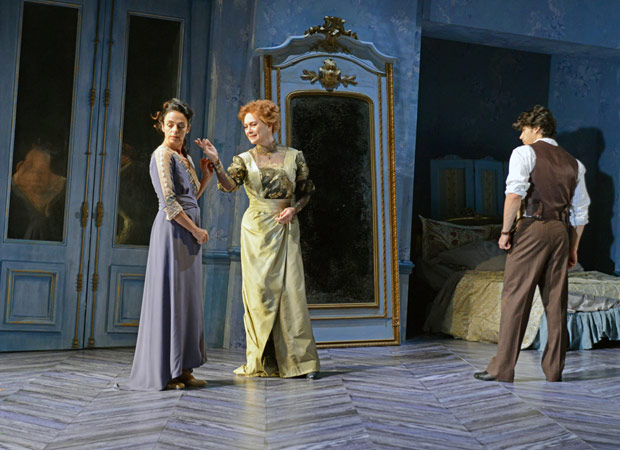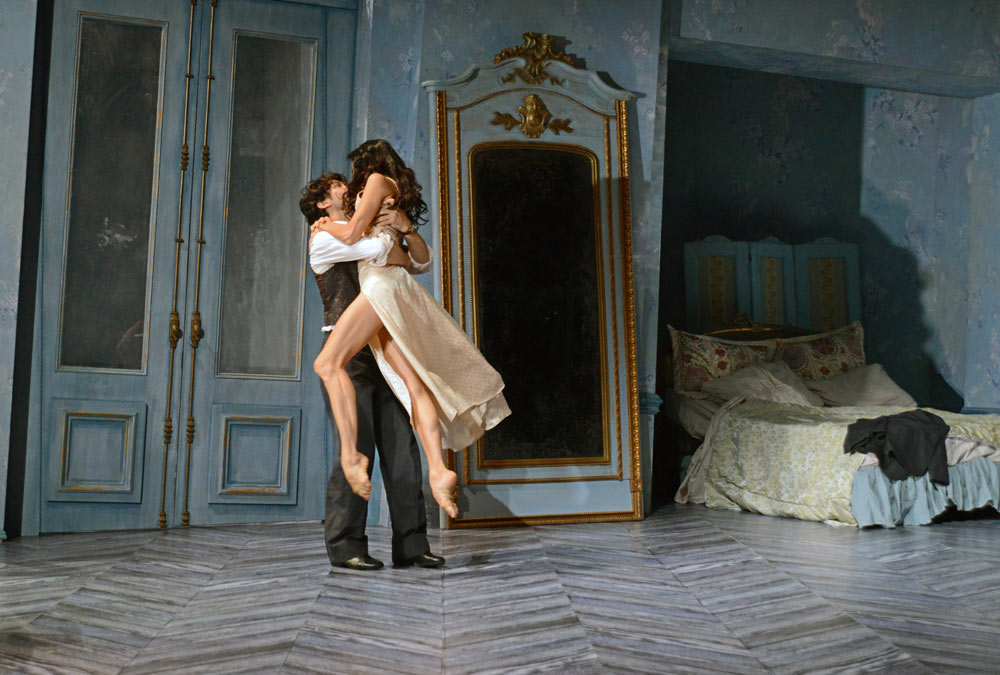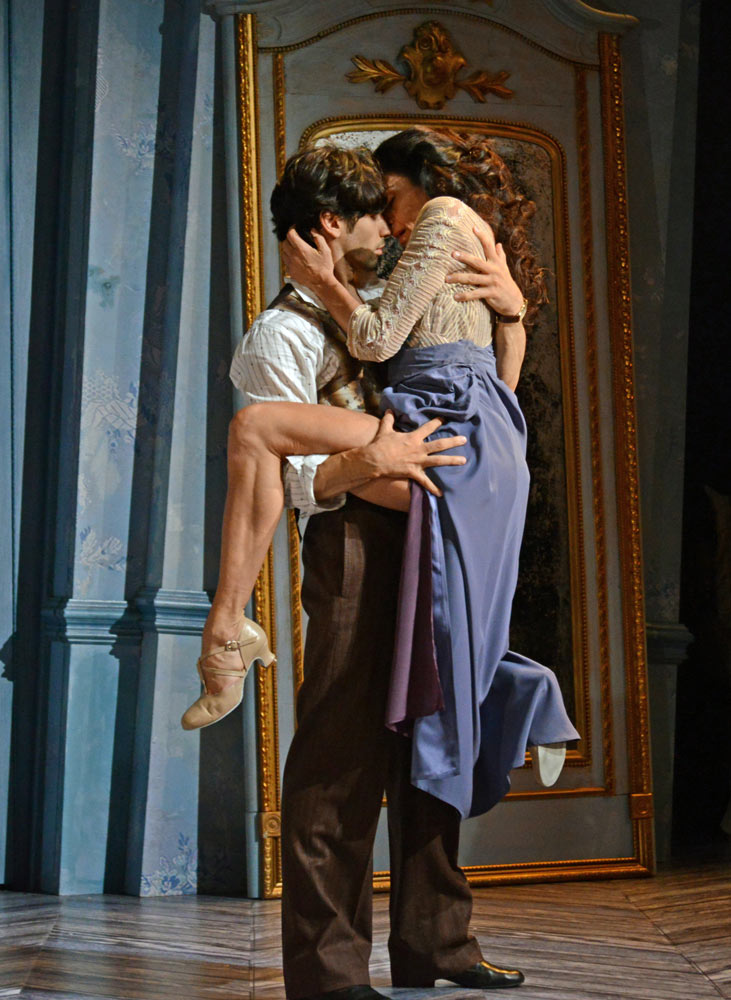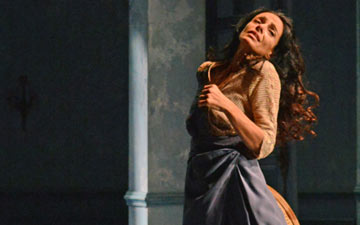
© Dave Morgan, courtesy the Royal Opera House. (Click image for larger version)
Martha Clarke’s Chéri
with Alessandra Ferri and Herman Cornejo
London, Linbury Studio Theatre
29 September 2015
Interview with Martha Clark
Gallery of pictures by Dave Morgan
marthaclarke.com
www.roh.org.uk
Though Martha Clarke drew on two novellas by Colette, Chéri (1920) and La Fin de Chéri (1926), for her dance-theatre creation, it’s actually an alternative version of Frederick Ashton’s Marguerite and Armand (based on Dumas’ La Dame aux Camélias). The story is very similar: a Parisian courtesan is obliged to renounce her young lover so that he can return to ‘proper’ society; they both suffer the loss of their true passion; the end of the affair results in death.
In both one-act works, the doomed lovers are renowned ballet dancers, she near the end of her career, he still in his prime. They express themselves through the movement language that is instinctive to them as dramatic dance-actors. Where Ashton choreographed beautiful ballet steps, Clarke concentrates on naturalistic gestures and embraces, though the dancers’ trained elegance is ever-present.

© Dave Morgan, courtesy the Royal Opera House. (Click image for larger version)
Clarke has distilled Colette’s stories of a Parisian demi-monde into just three characters: the older woman, Léa (Alessandra Ferri), the lover half her age, nicknamed Chéri (Herman Cornejo, from American Ballet Theatre) and the boy’s mother, Charlotte (the actress Francesca Annis). The action takes place in an apartment that is both love nest and claustrophobic prison. David Zinn’s set suggests several rooms, lit by Christopher Akerlind to seem enticingly warm or bleakly grey. Mirrors reflect the lovers to themselves in their intimate world, Léa apprehensive about signs of ageing, Chéri adoring.
In the first scene, they are seen in the morning-after glow of a night of love making. Cornejo whirls Ferri so that she flies, lighter than air, back arched in ecstasy. There’s no indication that anything could trouble them until Mother barges in from the world outside to inform Chéri that (like Siegfried), it’s time he got married. The lovers are thrown into disarray, their complex emotions struggling for expression.

© Dave Morgan, courtesy the Royal Opera House. (Click image for larger version)
Clarke has given her interpreters plenty of leeway to battle with their agonising dilemma. Sarah Rothenberg at the piano pours out music from composers contemporary with Colette’s writing as Cornejo pins Ferri against a wall: she tries to reject him, as she knows she must for his sake. Both are angry but it’s her agony: she is in turn mature, maternal, craven, besotted. They stare at each other in sudden stillness and silence, until she leaps at him, racked by desire that can’t be denied. This isn’t choreography so much as irresistible physical reaction. Ferri seems to be living her role as Léa, while Cornejo is understandably overwhelmed as Chéri.
In the next scene, complacent mother Charlotte arrives with boastful postcards from her son on his honeymoon, which she flaunts to Léa. Chéri is not as nice as he looks – he’s a man-child with a nasty streak, as his mother admits. Léa hurls herself at the walls and the floor, scarcely knowing how to contain her distress, now that she is alone. We’ll see a repeat of her desperate moves later in the piece.

© Dave Morgan, courtesy the Royal Opera House. (Click image for larger version)
When Chéri returns to claim his sexual rights from Léa, she resists and then succumbs, in the most painful scene in the drama. After being brutal with her, he puts his head in her lap, cups her face tenderly in his hands. In a reprise of the first scene, they end up in bed. The morning after, she’s besotted, while he’s regretful. Why? Colette knew: he feels trapped. Ferri’s Léa is a broken woman, suddenly collapsing in his arms, knowing she cannot be his future.
A piano interlude and an intervention from Mother reveal the after-shock of the First World War. What has been essentially Léa’s story up till now gives way to Chéri’s, as he cannot come to terms with his blasted life. It is now his turn to suffer, echoing Léa’s previous moves and gestures in her absence. He climbs on her bed, nuzzles her dressing gown just as she kissed his shirt, rolls on the floor as she did when he left her. Though the repetition is poignantly effective, the inclusion of virtuoso male steps in Chéri’s concluding solo – batterie, a manège of leaps – is incongruous and unnecessary. We don’t need to be reminded that Cornejo, like Nureyev before him, is a spectacular dancer.

© Dave Morgan, courtesy the Royal Opera House. (Click image for larger version)
The ending, a coda acknowledging Colette’s sequel six years later, compromises the drama in the theatre. We’ve been caught up in Léa’s sacrifice for love; we’re not really concerned with spoilt Chéri’s post-war misery. Cornejo is a splendid actor, as well as partner, but Ferri’s anguish is the tortured heart of the piece. Clarke has enabled her to be her age, a mature woman with a still-youthful body and ever- passionate emotions, much as Ashton achieved with Fonteyn in Marguerite and Armand: Ferri’s next role?

















You must be logged in to post a comment.